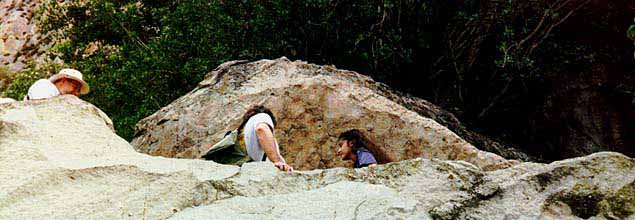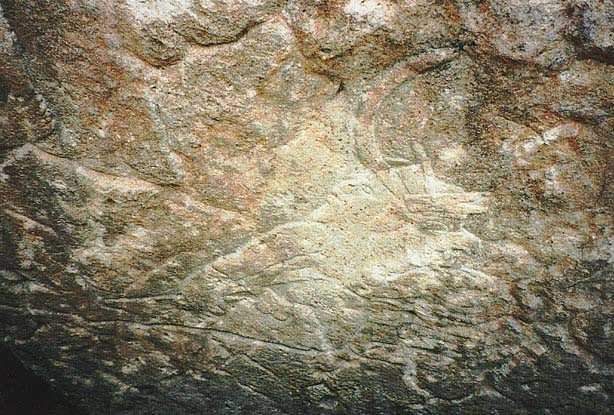

Click on the thumbnail photograph or underlined
text to see the picture in greater detail.
Links will work faster if you allow the entire page to load.
Page 1 of 2
| Click this photo for a short background on Chalcatzingo and the recent archaeological work done there, including bibliography, by archaeologists Maria del Rocio Aviles and David C. Grove. | |
| View of Cerro Delgado and Cerro Chalcatzingo from the town of Chalcatzingo. | |
| View of Chalcatzingo's principle mound and ceremonial center from the Cerro Chalcatzingo. | |
| Monument 1, also called "El Rey", depicts a person seated in a zoomorphic cave. The cave appears to issue wind-like scrolls, and is associated with stylized depictions of clouds and raindrops. The actual carving is located at the head of a major drainage for the site of Chalcatzingo. The cave mouth is assumed to be a representation of the open mouth of an earth supernatural, placing the person seated inside in a powerful cosmic location. | |
| Monument 1 Detail. The person in the cave appears to be a ruler sitting on a throne or bench. He or she is wearing an elaborate headdress and is holding a bar which is decorated with the same scroll design that is found on the bench. | |
 |
Monument 2, also called the "Marching Olmecs", is currently difficult to view or photograph. In this picture, archaeologist Maria del Rocio Aviles from the University of Illinois shows visitors the hidden carvings. The carvings once stood upright and were more easily seen, but through natural processes the rocks have settled to their current positions. The carving depicts elaborately clad personages approaching a reclined individual. |
 |
Detail of the "Marching Olmecs". The reclining figure can be seen in the center of this photo. The other figures (see next photo) all wear olmec-style masks on their faces, but this figure has his mask turned to the back of his head. Some researchers have stated that the reclining figure is naked, and that his genitals appear in the carving. Others believe that this is simply a portion of his attire which has been "touched up" by visitors over the years. |
|
|
Detail of the "Marching Olmecs". This is the most visible figure in the depicted procession. The person wears a mask that is easily recognizable as being in an "Olmec" style reminiscent of the distant Gulf Coast culture. He holds a staff of some kind that may be a weapon, or it may be some kind of prop in a dance or ceremony. He and one other person face the reclining figure, while one masked person seems to be walking away from the scene (not visible in this photo). |
| Chalcatzingo's carved altar is located in a sunken patio. Like the so-called table-top altars found in the Gulf Coast, this altar may have functioned as a throne. However, unlike the Gulf Coast specimens, this altar is made up of many individually carved pieces of stone, and functioned as a sarcophagus for a member of Chalcatzingo's elite. |
Chalcatzingo I |
|